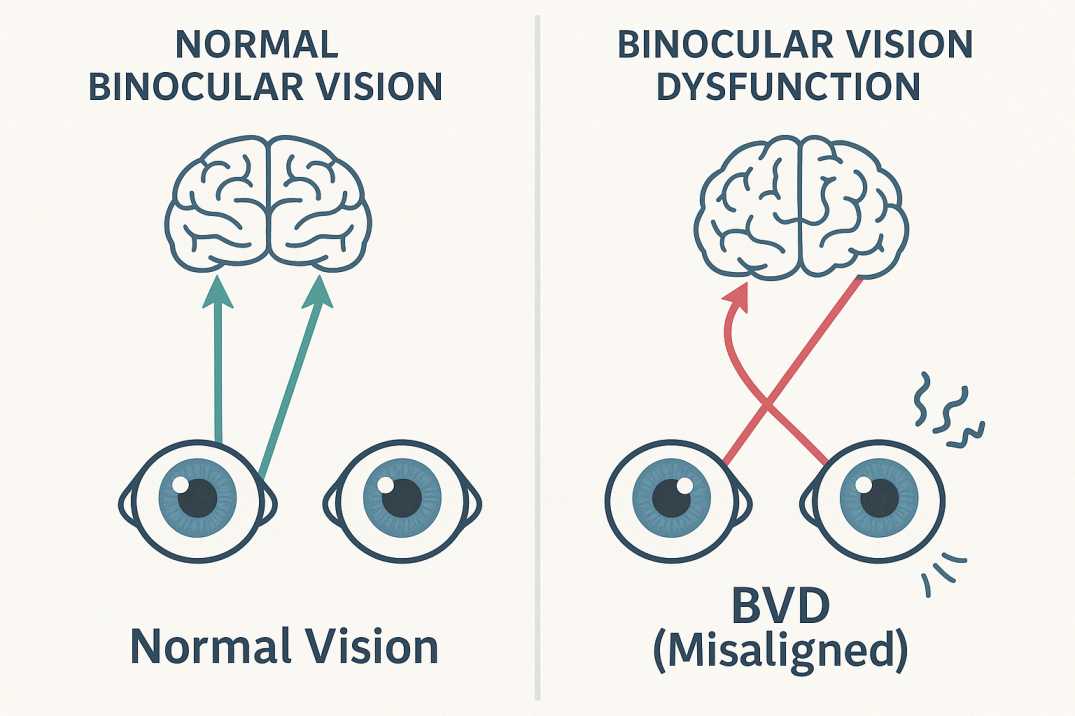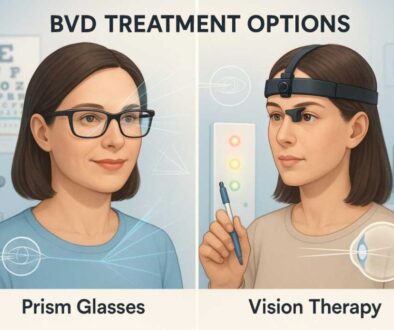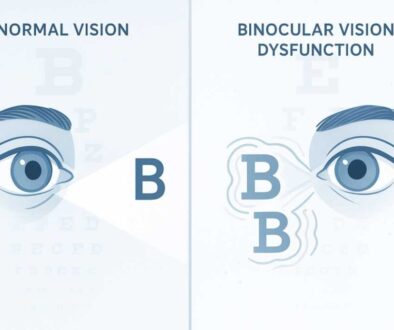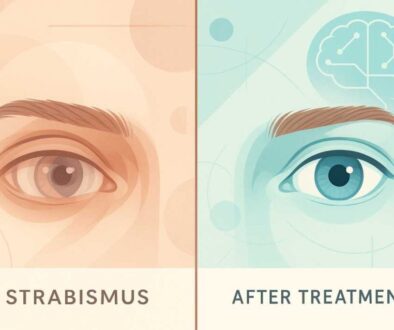Headaches & Eye Strain: Could It Be BVD? Expert Guide

Persistent headaches and eye strain could signal Binocular Vision Dysfunction—a frequently overlooked condition that affects how your eyes work together. Learn the symptoms, causes, and proven treatments from leading vision therapy specialists.
Do you experience persistent headaches that intensify after reading or computer work? Does your vision feel strained and fatigued, particularly during focused visual tasks? If conventional treatments have failed to provide lasting relief, the answer to your discomfort may be more complex than you realize. Binocular Vision Dysfunction (BVD) could be the missing link in your healthcare puzzle.
Recent studies indicate that approximately 10-20% of the general population experiences symptoms associated with binocular vision disorders, with some research suggesting that up to 56% of adults and adolescents may have mild symptoms that interfere with daily activities. This frequently misdiagnosed condition affects the intricate coordination between your eyes, triggering a cascade of symptoms that can profoundly impact your quality of life.
Understanding BVD is crucial for anyone seeking answers to chronic visual discomfort. Healthcare professionals increasingly recognize this condition as a significant contributor to unexplained headaches, reading difficulties, and general visual fatigue that traditional treatments fail to address.
What Is Binocular Vision Dysfunction (BVD)?
Binocular Vision Dysfunction represents a complex visual condition wherein the eyes struggle to function as a unified, coordinated system. While each eye may demonstrate excellent individual visual acuity, even subtle misalignment between the eyes can compel the brain to work overtime, attempting to merge two slightly disparate images into a coherent visual experience.
This continuous compensatory process places extraordinary demands on the eye muscles and visual processing system, manifesting in the characteristic symptoms of BVD: persistent headaches, chronic eye strain, dizziness, and reading comprehension difficulties.
The Mechanics of Normal Binocular Vision
In optimal binocular vision, the eyes operate in perfect synchronization, transmitting precisely matched signals to the brain. This harmonious coordination enables several critical visual functions:
- Unified image perception: Creating a single, clear visual representation instead of double vision
- Accurate depth perception: Precisely judging distances and spatial relationships
- Seamless focusing: Effortlessly transitioning between near and distant objects
- Visual stability: Maintaining consistent vision during head and body movements
When BVD disrupts this delicate equilibrium, the visual system enters a state of chronic stress, continuously attempting to compensate for the underlying misalignment.
The Connection Between BVD and Headaches
Headaches and dizziness are the two most common symptoms associated with BVD. Research indicates that a significant portion of adults with this condition experience frequent headaches, particularly those that worsen with visual tasks. These aren’t ordinary headaches – they have distinct characteristics that set them apart:
BVD-Related Headache Patterns
- Location: Often concentrated around the temples, forehead, or base of the skull
- Timing: Typically worsens with visual tasks like reading, computer work, or driving
- Quality: May feel like constant pressure or throbbing pain
- Triggers: Intensify in large spaces with tall ceilings (malls, airports, big box stores)
The headaches occur because your eye muscles are working overtime to maintain proper alignment. This muscular strain extends beyond your eyes, affecting the muscles in your head, neck, and shoulders – creating a web of tension that can trigger debilitating headaches.
Post-Concussion Headaches and BVD
Research shows that 30% to 50% of adults with BVD report lingering symptoms after a concussion or traumatic brain injury. These individuals often experience particularly intense, constant headaches that traditional treatments fail to address effectively.
Understanding Eye Strain in BVD
Asthenopia, commonly referred to as eye strain, represents another cardinal manifestation of BVD, presenting through various symptom complexes:
- Ocular fatigue: Persistent tiredness and soreness, particularly pronounced following extended visual tasks
- Burning or acute sensations: Sharp or burning discomfort localized to the periocular region
- Photophobia: Heightened sensitivity to ambient light and glare phenomena
- Accommodative difficulties: Impaired ability to maintain sustained focus during reading or digital screen work
- Compensatory behaviors: Frequent blinking, eye rubbing, or squinting to achieve visual relief
Unlike conventional digital eye strain resulting from prolonged device usage, BVD-related asthenopia persists despite optimal environmental conditions, including appropriate illumination, ergonomically designed workstations, and adherence to recommended visual hygiene practices. This persistence occurs because the fundamental etiology—ocular misalignment—continues to stress the visual system irrespective of external modifications. Many individuals experiencing chronic eye strain discover that conventional remedies provide only transient relief because they fail to address the underlying pathophysiology: binocular vision dysfunction.
Additional Symptoms That May Indicate BVD
BVD manifests through a complex symptom constellation that extends far beyond visual complaints, affecting multiple physiological and cognitive systems:
Visual Manifestations
- Diplopia or overlapping vision: Double or superimposed visual images
- Intermittent visual blur: Fluctuating clarity that may vary throughout the day
- Stereopsis deficits: Impaired depth perception affecting spatial judgment
- Glare intolerance: Difficulty processing reflected light from various surfaces
- Metamorphopsia: Visual distortions appearing as shadowed or layered images
Vestibular and Motor Symptoms
- Vertigo and balance disturbances: Feelings of unsteadiness or spatial disorientation
- Motion sensitivity: Discomfort during vehicular travel or exposure to moving stimuli
- Cervical and shoulder tension: Musculoskeletal pain resulting from compensatory head positioning
- General fatigue: Systemic exhaustion from continuous visual-motor compensation
Cognitive and Behavioral Manifestations
- Attention and concentration deficits: Difficulty sustaining mental focus
- Reading comprehension challenges: Impaired textual processing and retention
- Environmental anxiety: Discomfort in visually complex spaces such as shopping centers or crowded venues
- Driving avoidance: Reluctance to operate vehicles, particularly during challenging conditions
Sleep-Related Complications
- Photophobic sleep patterns: Requiring complete darkness for sleep initiation
- Sleep fragmentation: Restless sleep secondary to ocular muscle tension
- Rapid eye movement disturbances: Difficulty with visual focusing affecting sleep quality
Common Misdiagnoses: Why BVD-Related Headaches Go Undetected
One of the biggest challenges with BVD is that headaches and eye strain symptoms are frequently misdiagnosed or overlooked entirely. Many patients visit multiple specialists before receiving an accurate diagnosis, often being told their persistent headaches are caused by:
- Migraine disorders
- Sinus headaches
- Chronic fatigue syndrome
- Anxiety or panic disorders
- Learning disabilities (ADD/ADHD)
- Vertigo or vestibular disorders
- TMJ dysfunction
- Cervical spine problems
For residents of Atlanta, Marietta, and surrounding Georgia communities, finding a BVD specialist with advanced training in binocular vision assessment is crucial for accurate diagnosis and effective treatment.
Why Traditional Eye Exams Miss BVD-Related Eye Strain
Standard comprehensive eye exams typically focus on:
- Visual acuity (how well each eye sees individually)
- Major eye diseases and health conditions
- Basic refractive errors (nearsightedness, farsightedness, astigmatism)
However, these exams rarely test how well your eyes work together under stress or during prolonged visual tasks – the exact conditions that reveal BVD and trigger eye strain symptoms.
Etiology and Risk Factors of BVD
Understanding the multifactorial etiology of BVD provides insight into why certain individuals develop this condition while others maintain optimal binocular function:
Developmental and Congenital Factors
- Craniofacial asymmetry: Anatomical variations where one eye is positioned physically higher than the other
- Extraocular muscle dysfunction: Congenital weakness or imbalance of the six extraocular muscles responsible for eye movement
- Genetic predisposition: Familial clustering suggests hereditary components, with symptoms often manifesting around the fourth decade of life
Acquired Etiologies
- Traumatic brain injury: Concussions and head trauma can disrupt the delicate neurological coordination between the eyes and brain
- Cerebrovascular events: Strokes or transient ischemic attacks may affect the neural pathways controlling eye movement.
- Neurodegenerative conditions: Progressive diseases affecting the central nervous system
- Age-related changes: Natural deterioration of extraocular muscle strength and neural coordination
Contributing Vision Conditions
- Convergence insufficiency: Inadequate ability of the eyes to turn inward for near tasks, leading to headaches, eye strain, and reading difficulties due to poor motor fusion
- Strabismus spectrum disorders: Manifesting as crossed eyes, wall eyes, or other alignment abnormalities
- Uncorrected refractive errors: Untreated vision problems that create additional stress on the visual system, particularly higher-order astigmatism that complicates binocular fusion
Diagnosing BVD: Specialized Testing Required
Diagnosing BVD requires specialized testing that goes far beyond a standard eye exam. A comprehensive binocular vision evaluation typically includes:
Advanced Diagnostic Tests
- Binocular Vision Dysfunction Questionnaire (BVDQ): Screening tool to identify likely BVD cases
- Eye alignment measurements: Precise testing for subtle misalignments
- Vergence testing: Assessment of how eyes move together
- Accommodation testing: Evaluation of focusing ability
- Eye movement tracking: Analysis of how eyes follow objects
- Stress testing: Observing eye coordination under fatigue
The Importance of Specialized Care
Not all eye care professionals are trained in diagnosing and treating BVD. Seeking care from a specialist in binocular vision or neuro-optometry ensures:
- Proper recognition of subtle symptoms
- Appropriate diagnostic testing
- Access to specialized treatment options
- Ongoing monitoring and care adjustments
Treatment Options for BVD
The good news is that BVD is highly treatable once properly diagnosed. Treatment options have evolved significantly, offering hope for long-term symptom relief:
Micro-Prism Lenses: The Gold Standard Treatment
Micro-prism lenses are the most effective treatment for most BVD cases. These specialized lenses work by:
- Realigning images: Bending light slightly to help your brain merge images from both eyes
- Reducing eye muscle strain: Eliminating the constant correction cycle
- Providing immediate relief: Many patients notice improvement within minutes of wearing trial lenses
Research indicates that many patients notice significant improvement in symptoms when wearing properly prescribed micro-prism lenses, often experiencing noticeable relief during their first visit with trial lenses.
How Micro-Prism Lenses Work
Unlike regular glasses that correct refractive errors, micro-prism lenses specifically address eye alignment issues. They “trick” your brain into thinking your eyes are properly aligned, preventing the strain that causes BVD symptoms.
Vision Therapy: Retraining Your Visual System
Vision therapy involves supervised exercises designed to improve eye coordination and strengthen the connection between your eyes and brain. This treatment approach:
- Enhances binocular coordination: Teaches eyes to work together more efficiently
- Improves focusing abilities: Strengthens accommodation and convergence
- Reduces symptom severity: Can provide long-term improvement in visual function
- Complements prism therapy: Often used alongside micro-prism lenses for optimal results
Progressive Treatment Approach
BVD treatment typically follows a progressive model:
- Initial assessment and trial lenses: Testing immediate response to prism correction
- Prescription refinement: Fine-tuning prism power as eyes adapt
- Progressive relaxation period: Allowing the visual system to adjust gradually
- Follow-up evaluations: Regular monitoring and prescription adjustments
The Impact of Untreated BVD
Leaving BVD untreated can have far-reaching consequences that extend beyond physical discomfort:
Academic and Professional Impact
- Reduced reading comprehension: Difficulty processing written information
- Decreased work productivity: Struggling with computer-based tasks
- Career limitations: Avoiding visually demanding professions
- Educational challenges: Children may be misdiagnosed with learning disabilities
Quality of Life Effects
- Social isolation: Avoiding crowded places or social activities
- Driving difficulties: Fear or discomfort behind the wheel
- Recreational limitations: Avoiding sports or hobbies requiring visual precision
- Emotional distress: Frustration from unexplained symptoms
Progressive Worsening
BVD symptoms often worsen over time as the visual system becomes increasingly fatigued. What may start as occasional headaches can evolve into debilitating daily symptoms that significantly impact your life.
Contemporary Research and Scientific Evidence
Recent advances in BVD research have significantly enhanced our understanding of this condition and its widespread impact on patient quality of life:
Key Scientific Findings
A 2025 comprehensive study examining global headache trends confirmed that headache disorders continue to represent a leading cause of disability worldwide, with many cases potentially attributable to undiagnosed visual dysfunction. The research specifically highlighted that headache and musculoskeletal pain in school-aged children demonstrate significant associations with uncorrected vision problems, establishing a clear evidence-based connection between visual stress and somatic symptoms that supports the BVD-headache relationship.
Digital Eye Strain and BVD Correlation
Contemporary research published in 2024 has illuminated the increasing prevalence of digital eye strain, revealing symptom profiles that closely parallel BVD manifestations:
- Cephalgia patterns following prolonged screen engagement
- Ocular fatigue during sustained digital tasks
- Accommodative dysfunction and focusing difficulties
- Cervical and shoulder tension resulting from compensatory postural adaptations
This symptom overlap suggests that numerous cases of presumed “digital eye strain” may represent undiagnosed BVD exacerbated by contemporary visual demands and extended near-work requirements.
Living with BVD: Daily Management Strategies
While professional treatment is essential, several strategies can help manage BVD symptoms in daily life:
Environmental Modifications
- Optimize lighting: Use consistent, glare-free illumination
- Adjust screen settings: Reduce blue light and increase text size
- Take frequent breaks: Follow the 20-20-20 rule (every 20 minutes, look at something 20 feet away for 20 seconds)
- Modify workspace ergonomics: Ensure proper monitor height and distance
Lifestyle Adaptations
- Manage stress: High stress can worsen BVD symptoms
- Prioritize sleep: Good sleep hygiene supports visual system recovery
- Stay hydrated: Proper hydration helps maintain eye comfort
- Limit trigger activities: Reduce exposure to visually challenging environments when possible
Coping Strategies
- Plan activities: Schedule visually demanding tasks during peak energy hours
- Use assistive tools: Audio books, voice-to-text software, and other accommodations.
- Communicate needs: Help family and colleagues understand your visual challenges.
- Build support networks: Connect with others who understand BVD
Special Considerations for Children
BVD can significantly impact children’s development and academic success. Studies suggest that BVD may be present in a significant portion of children diagnosed with ADD/ADHD and learning problems, making early detection crucial.
Signs of BVD in Children
- Difficulty with reading comprehension
- Frequent complaints of headaches or tiredness
- Avoiding homework or reading activities
- Closing one eye during visual tasks
- Poor hand-eye coordination
- Behavioral issues in school settings
Importance of Early Intervention
Treating BVD in children can:
- Prevent academic struggles: Address learning difficulties at their source
- Improve self-esteem: Reduce frustration from unexplained challenges
- Support normal development: Allow proper visual skill development
- Prevent compensation patterns: Avoid developing harmful visual habits
When to Seek Professional Help
Consider consulting a BVD specialist if you experience:
- Persistent headaches that worsen with visual tasks or screen time
- Chronic eye strain not relieved by rest, improved lighting, or ergonomic improvements
- Dizziness or balance problems, especially in visually complex environments
- Reading difficulty, including losing your place or poor comprehension
- Driving discomfort, particularly at night or in heavy traffic, is often accompanied by headaches
- Multiple failed treatments for chronic headaches, migraines, or recurring eye strain
What to Expect During Your Visit
A comprehensive BVD evaluation typically involves:
- Detailed symptom questionnaire: Assessment of your specific experiences
- Medical history review: Understanding potential contributing factors
- Specialized vision testing: Advanced binocular vision assessment
- Trial lens fitting: Testing immediate response to prism correction
- Treatment planning: Developing a personalized approach to your care
Finding the Right Care Provider
Not all eye care professionals are trained in BVD diagnosis and treatment. Look for providers who:
- Specialize in binocular vision: Have specific training in BVD assessment
- Use advanced testing: Employ specialized diagnostic equipment
- Offer micro-prism lenses: Can prescribe and fit these specialized glasses
- Provide ongoing care: Monitor progress and adjust treatment as needed
Questions to Ask Potential Providers
- How many BVD patients do you treat annually?
- What diagnostic tests do you use for BVD assessment?
- Do you prescribe micro-prism lenses?
- What is your success rate with BVD treatment?
- Do you offer vision therapy services?
The Future of BVD Treatment
Research into BVD continues to evolve, with new treatment approaches and diagnostic tools being developed:
Emerging Technologies
- Computer-assisted diagnostics: More precise measurement of eye alignment
- Personalized prism calculations: Advanced formulas for optimal correction
- Digital vision therapy: App-based exercises for convenient treatment
- Telemedicine monitoring: Remote follow-up and care coordination
Increased Awareness
As understanding of BVD grows within the medical community, we can expect:
- Better recognition: Earlier diagnosis and appropriate referrals
- Improved outcomes: More effective treatment protocols
- Insurance coverage: Greater recognition of BVD as a legitimate medical condition
- Prevention strategies: Identifying at-risk individuals before symptoms develop
Professional Resources and Clinical Guidance
Healthcare professionals and patients seeking specialized BVD care should prioritize providers who demonstrate:
- Specialized binocular vision training: Advanced certification in BVD assessment and treatment
- Comprehensive diagnostic capabilities: Access to specialized testing equipment and protocols
- Micro-prism lens prescribing experience: Demonstrated competency in precise optical corrections
- Ongoing professional development: Commitment to current best practices in neuro-optometric care
Clinical Consultation Recommendations
- What specific diagnostic protocols do you employ for BVD assessment?
- How many BVD patients do you evaluate and treat annually?
- Do you prescribe and fit micro-prism lenses?
- What is your clinical success rate with BVD therapeutic interventions?
- Do you provide vision therapy services as complementary treatment?
Professional Development and Future Directions
Research into BVD continues to evolve, with emerging treatment modalities and diagnostic technologies being developed:
Technological Advances
- Computer-assisted diagnostics: Enhanced precision in eye alignment measurement
- Personalized prism calculations: Advanced algorithms for optimal correction determination
- Digital vision therapy platforms: Technology-assisted exercises for convenient treatment delivery
- Telemedicine applications: Remote monitoring and care coordination capabilities
Clinical Recognition
As BVD awareness expands within the healthcare community, we anticipate:
- Enhanced diagnostic recognition: Earlier identification and appropriate specialist referrals
- Improved therapeutic outcomes: More effective treatment protocols and patient management
- Insurance recognition: Greater acknowledgment of BVD as a legitimate medical condition requiring treatment
- Preventive strategies: Identification of at-risk populations before symptom development
References and Additional Resources
The information presented in this comprehensive review is derived from current research and clinical evidence from leading medical institutions and vision therapy specialists. For additional reading and verification of the data presented, healthcare professionals and patients may refer to these authoritative sources:
Scientific and Medical References
-
Cleveland Clinic – Binocular Vision Dysfunction (BVD): Symptoms & Treatments (July 2025)
Comprehensive medical overview of BVD from a leading healthcare institution
https://my.clevelandclinic.org/health/diseases/binocular-vision-dysfunction-bvd -
Scientific Reports – Headache and Musculoskeletal Pain in School Children (2024)
Peer-reviewed research demonstrating the connection between vision problems and headaches
https://www.nature.com/articles/s41598-021-81497-w -
Vision Specialists Institute – What is Binocular Vision Dysfunction (BVD)? (March 2025)
Comprehensive clinical resource on BVD symptoms, causes, and treatment options
https://vision-specialists.com/vision-health/bvd/what-is-bvd/
These sources provide additional depth on the topics covered in this article and represent current best practices in BVD diagnosis and treatment. All statistics and treatment information cited are derived from these and other peer-reviewed sources in the field of neuro-optometry and binocular vision.
Conclusion: Advancing Understanding of BVD in Clinical Practice
Headaches and eye strain need not represent permanent impediments to optimal quality of life. For individuals who have experienced persistent symptoms despite comprehensive therapeutic trials, BVD may represent the previously unidentified etiology underlying their discomfort.
The critical factor lies in recognizing that these symptoms constitute legitimate medical concerns deserving thorough investigation by qualified professionals. With appropriate diagnosis and evidence-based treatment, many individuals with BVD experience substantial improvements in their overall well-being and functional capacity.
Clinical Action Framework
- Comprehensive symptom assessment using validated screening instruments to evaluate BVD probability
- Specialist consultation with qualified professionals experienced in binocular vision disorders.
- Thorough diagnostic evaluation to determine the presence and extent of BVD
- Evidence-based treatment planning incorporating micro-prism lenses and vision therapy as indicated
- Systematic follow-up care to ensure optimal therapeutic outcomes and prescription refinement
The medical community’s growing recognition of BVD represents a significant advancement in understanding the complex relationships between visual function and systemic symptoms. Patients experiencing unexplained headaches and eye strain should not accept these symptoms as inevitable, but rather seek appropriate evaluation from specialists equipped to identify and treat this frequently overlooked condition.
With proper diagnosis and therapeutic intervention, the prospect for symptom resolution and restoration of normal visual function remains excellent for most individuals with BVD.
About the Author: Dr. David Cook brings over four decades of specialized expertise in vision therapy and binocular vision disorders to the field of optometric care. His extensive clinical experience and dedication to advancing the understanding of BVD have benefited thousands of patients seeking relief from chronic headaches and eye strain. Dr. Cook’s practice maintains an exclusive focus on vision therapy, ensuring that patients receive the highest level of specialized care for complex visual conditions such as BVD. His contributions to the field include numerous professional presentations and continued education of healthcare providers in the recognition and treatment of binocular vision dysfunction.
Professional Disclaimer: This article is intended for educational and informational purposes only and should not be construed as a substitute for professional medical advice, diagnosis, or treatment. Individuals experiencing symptoms suggestive of BVD should consult with qualified eye care professionals for a comprehensive evaluation and appropriate therapeutic intervention. Treatment outcomes may vary among individuals, and all medical decisions should be made in consultation with licensed healthcare providers.
FAQs
-
-
BVD is a condition where eyes are misaligned, forcing eye muscles to overwork, causing headaches, eye strain, and dizziness from double vision or poor focus.
-




